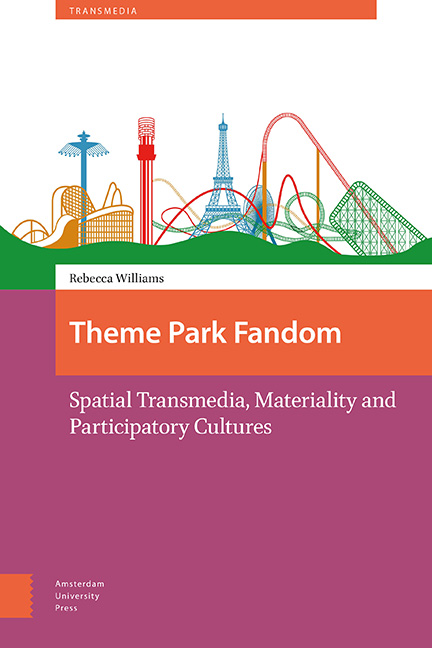Book contents
- Frontmatter
- Contents
- Acknowledgements
- 1 Introduction
- 2 Understanding the Contemporary Theme Park : Theming, Immersion and Fandom
- 3 Fandom, Brandom and Plandom : Haptic Fandom, Anticipatory Labour and Digital Knowledge
- 4 Extending the Haunted Mansion : Spatial Poaching, Participatory Narratives and Retrospective Transmedia
- 5 Of Mice and Minions : ‘Ani-embodiment’ and ‘Metonymic Celebrity’ in the Theme Park Character Encounter
- 6 Turkey Legs, Dole Whip and Duff : Consumables, Diegetic Paratexts and ‘Cult-Culinary’ Objects
- 7 Embodied Transmedia and Paratextual-Spatio Play : Consuming, Collecting and Costuming Theme Park Merchandise
- 8 Replacing and Remembering Rides : Ontological Security, Authenticity and Online Memorialization
- 9 Conclusion: Ways Forward for Theme Park and Fan Studies
- Index
4 - Extending the Haunted Mansion : Spatial Poaching, Participatory Narratives and Retrospective Transmedia
Published online by Cambridge University Press: 20 November 2020
- Frontmatter
- Contents
- Acknowledgements
- 1 Introduction
- 2 Understanding the Contemporary Theme Park : Theming, Immersion and Fandom
- 3 Fandom, Brandom and Plandom : Haptic Fandom, Anticipatory Labour and Digital Knowledge
- 4 Extending the Haunted Mansion : Spatial Poaching, Participatory Narratives and Retrospective Transmedia
- 5 Of Mice and Minions : ‘Ani-embodiment’ and ‘Metonymic Celebrity’ in the Theme Park Character Encounter
- 6 Turkey Legs, Dole Whip and Duff : Consumables, Diegetic Paratexts and ‘Cult-Culinary’ Objects
- 7 Embodied Transmedia and Paratextual-Spatio Play : Consuming, Collecting and Costuming Theme Park Merchandise
- 8 Replacing and Remembering Rides : Ontological Security, Authenticity and Online Memorialization
- 9 Conclusion: Ways Forward for Theme Park and Fan Studies
- Index
Summary
Abstract
This chapter offers detailed discussion of the transmediality of theme parks and how their narratives and experiences extend across media forms. It takes Disney's Haunted Mansion as an extended case study, a ride which has been turned into a feature film, but has also seen its narrative universe expanded across comics and novelizations, board games, and video games. Despite the fact that the ride lacks a coherent story, fans have demanded a greater narrative to the ride, causing tensions between Disney and its fans. Introducing the concepts of spatial poaching and retrospective transmedia, the chapter focuses on how producers and fans co-construct transmedia narratives through physical spaces, and over extended periods of time.
Keywords: spatial poaching, retrospective transmedia, Haunted Mansion, fan/producer relationships, spatial transmedia
Introduction
Having outlined how the contemporary theme park utilizes forms of digital media and new technologies to allow guests to plan their trips in detail and pleasurably anticipate their experiences, as well as the importance of an unofficial participatory culture, this chapter moves onto more detailed discussion of the intersections between such fannish attachments and transmedia narratives. It offers detailed analysis of the transmediality of theme park rides and the ways in which their narratives and experiences extend across media forms, beginning from Henry Jenkins’ definition of transmedia storytelling as ‘integrating multiple texts to create a narrative so large that it cannot be contained within a single medium’ (2006, p.95). As Jenkins notes,
In many ways, theme parks were one of the spaces where transmedia entertainment first emerged […] The practices of theme park designers, thus, paved the way for the special stories we now associate with games or virtual worlds, translating events in the stories into spaces which we can visit. (Jenkins in Lukas 2012, p. 246)
To begin to better understand the links between theme parks, transmediality and fandom, I turn here to an in-depth analysis of one specific ride, Disney's Haunted Mansion. This also allows a response to Rahn's assertion that ‘Disney's films and their effect on children are frequently scrutinized, as are the theme parks themselves, but little detailed attention has been given to individual theme park attractions’ (2011, p. 87). This
- Type
- Chapter
- Information
- Theme Park FandomSpatial Transmedia, Materiality and Participatory Cultures, pp. 101 - 132Publisher: Amsterdam University PressPrint publication year: 2020



